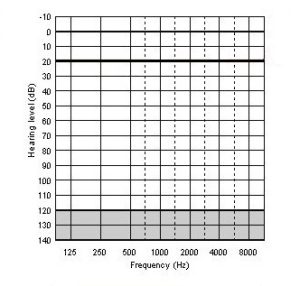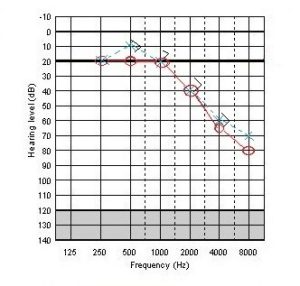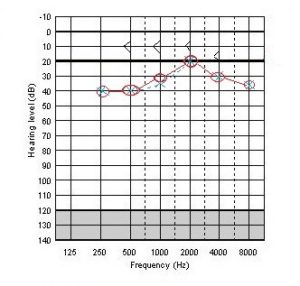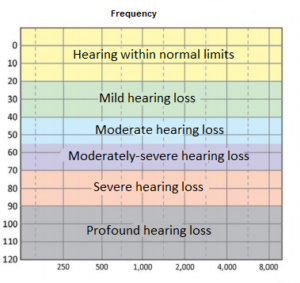How To Read Your Hearing Test Results
Like any medical assessment, having your hearing tested will mean getting results and having them explained to you. You can even request to have a copy of your results to take away with you. At your hearing test appointment you will be given a lot of information, and even if you have someone with you, it can be hard to remember everything that was said. Knowing how to read your hearing test results is a useful tool, so you can revisit the information when you are home in a more comfortable environment.
The Audiogram
A hearing test involves a number of steps and assessment procedures to find out your threshold of hearing (the softest sounds you can hear). The results of the audiometric assessment are plotted on an audiogram and compared to normal hearing levels. An audiogram is an inverted graph (upside down from most common graphs). Instead of the numeric value of zero being at the base of the graph, it is the uppermost point (although some audiograms go to -10dB).

The results on the audiogram indicate where the ‘pure tones’ of the main frequencies (pitches) in conversational speech are, as they are heard by you. Frequencies are measured using the Hertz scale (Hz) and arranged like a piano scale moving from low pitch sounds on the left hand side of the graph, up to higher frequencies on the right side. High frequency speech sounds, such as -‘s’, ‘f’, and ‘th’ – are compromised if you have a high-pitch hearing loss. If you have a low-frequency hearing loss, vowels and nasal sounds – ‘mm’, ‘n’, ‘ng’ – will be harder to discriminate.
At your hearing test, you will asked to listen to pure tones at various loudness levels. These tones are recorded in decibel (dB) levels. Decibels indicate the ‘intensity’ of sound. It’s easiest to think of this as how loud the sounds were turned up for you to be able to hear them. 0 dB on the audiogram does not mean ‘no sound’, just as 0° Celsius doesn’t indicate ‘no temperature’. It is a reference point. Every decade the International Organisation for Standardisation (ISO) assesses 100 otologically normal adults between the ages of 18 – 25 years to find out the softest sounds they can hear at each frequency. This then becomes the reference point of 0 dB and all audiometers (the equipment used to assess your hearing for the audiogram) are calibrated to this point to ensure a standardised assessment.
Hearing tests will generally assess your hearing levels in the frequencies of 250Hz, 500Hz, 1000Hz, 2000Hz, 4000Hz and 8000Hz. Depending on your hearing levels and the type of test being carried out (for example, workers’ compensation assessments), more frequencies may be tested. These can include: 750Hz, 1500Hz, 3000Hz and 6000Hz.
When you look at an audiogram you will see the frequencies are arranged from left to right across the top (or bottom) on the ‘X’ axis. Decibels go from the top of the graph, (0 dB) for the softest sounds, to loudest sounds (100+dB), on the ‘Y’ axis.
Symbols on the audiogram
You will see various symbols on the audiogram, once your hearing test has been finished. These can vary from country to country, and even state to state in Australia, however there are two universal symbols used around the world for Air Conduction testing:
O = Right ear
X = Left ear
The left and right ear may be coloured red for the right ear and blue for the left ear or they may just be coloured black – either is acceptable.
The X and O indicate your ears have been tested separately under headphones or with insert earphones with pure tones. The result from this test indicates your o hearing threshold – how loud the sound had to be made before you just heard it – for each frequency.
A screening hearing test will probably only have these two symbols. A diagnostic test involves a little more testing. You may also see symbols for Bone Conduction testing. Once Air Conduction testing is complete, the headphones (or insert earphones) are removed and a bone conductor is placed on your head. This instrument has three main parts:
- a little black box to vibrate the skull – placed behind one of your ears
- a thin headband that goes across the head diagonally
- an anchor piece to hold it in place on or near your temple
The bone conductor will vibrate your skull with different frequencies (usually 500Hz, 1000Hz, 2000Hz and 4000Hz). The vibration makes the fluid in the inner ear move, stimulating the hearing cells. This means only your inner ear is being tested with the bone conductor, giving your clinician important information about where the hearing loss in your ear could be. Bone conduction symbols could be any of the following:
- < or [ = right bone conduction
- > or ] = left bone conduction
Categorising Hearing Levels
Once your hearing has been assessed, your level of hearing will be classified in terms of severity of hearing loss and ‘site of lesion’ (where in your ear the problem is). If your hearing falls outside the normal range (0 dB – 20 dB), your hearing levels are said to have dropped.
Degree of hearing loss
The degree of your hearing loss is determined by looking at the Air Conduction results. There are a number of different scales used, but most are fairly similar to the ones below.
- Hearing within normal limits: 0 – 20 dB
- Mild hearing loss: 20 – 40 dB
- Moderate hearing loss: 40 – 55 dB
- Moderately-severe hearing loss: 55 – 70 dB
- Severe hearing loss: 70 – 90 dB
- Profound hearing loss: 90 dB +
Site of lesion
Site of lesion is determined by looking at the Air Conduction and Bone Conduction results together. Some hearing losses are more complicated than others, and may take an experienced clinician to interpret the results, but most hearing losses can be categorised in two groups:
- Sensorineural (inner ear: cochlear or retro-cochlear) hearing loss: The air and bone conduction results sit close together on the audiogram. All or most of the symbols will fall below the 20dB line:

- Conductive (outer and/or middle ear) hearing loss: The bone conduction results are in the normal range, but the air conduction results fall below the 20dB line:

Some hearing losses are a combination of both sensorineural and conductive problems and these are described as ‘mixed’ hearing losses.
Reading Your Audiogram
When reading your audiogram, first look at where all the symbols fall. The closer all the symbols are to the top of the audiogram graph, the better your hearing is. Then look to see if the bone conduction is in the normal range (above 20dB). If not, then you have a problem in your inner ear – a sensorineural hearing loss. If bone conduction is normal, but air conduction is not, then you have a conductive hearing loss. Often conductive losses can be medically treated and this should be the first thing you do – go to your doctor to see what treatments may be available to restore all or part of your hearing.
Other tests
Your audiologist may carry out further diagnostic tests including Speech Audiometry and Middle Ear Assessments. These tests can be more in-depth to interpret and are always considered alongside your audiogram readings.
Speech audiometry
Just like the pure tone testing, this test is carried out via headphones or insert earphones. This is a word recognition test. Here, you’ll be instructed to listen to single words and repeat them back. The words will be at a few different loudness levels – easy to hear, louder and softer. The clinician records your responses and then the testing is finished. These results are then compared to your audiogram as part of the diagnostic assessment of your hearing and to determine your suitability for hearing aids, if required. Your results are generally given in percentages to determine your speech discrimination ability for single words.
Middle Ear Assessment
Tympanometry is the most common form of middle ear assessment. This test looks at the health and function of your middle ear. A small ear tip is placed in your ear canal and you will feel a slight change in air pressure – like driving down a mountain. This is a quick test and the clinician is looking to record a tympanogram. There are a number of types of tympanograms and if you have a conductive hearing loss the clinician will be interested to see how your middle ear test relates to your audiogram result.
Discussion of Results
Always ask your clinician to discuss your results with you. If you are not clear on any aspect of the tests or what the results mean, get clarification from your clinician. It is part of their role as a Hearing Care Professional to ensure you understand your hearing test results and how this impacts on your communication.
Ask for a copy of your audiogram to take home. Go through it with your communication partners. Explain to them what your results mean for your hearing and how you can work together for better communication together.

